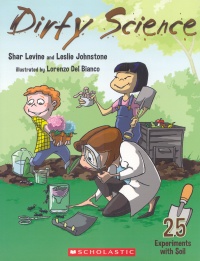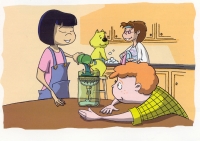| ________________
CM . . .
. Volume XX Number 32. . . .April 18, 2014
excerpt:
Dirty Science is the fourth publication by authors Shar Levine and Leslie Johnstone in Scholastic’s 25 Experiments series. Similar to Hockey Science: 25 Winning Experiments, Snowy Science: 25 Cool Experiments and Scary Science: 25 Creepy Experiments, Levine and Johnstone have developed 25 interesting and thought-provoking investigations for children interested in soil and the science of soil, also known as pedology.
Most remarkable is the seventh experiment, “Colour Change”, that uses pink and blue flowering hydrangea plants. Each week, coffee grounds are to be added to the soil of the pink hydrangea and the surface of the soil is to be covered with pine needles. Similarly, each week the soil of the blue hydrangea is to have dolomite lime added. Coffee grounds and pine needles are acidic, dolomite lime is basic or alkaline, and the anthocyanin pigments in hydrangea flowers can be pink or blue depending on the amount of aluminum that ends up in the plant. Acidic soils allow hydrangea plants to take up more aluminum than alkaline soils. As a result, at the end of the experiment, the flowers of the pink hydrangea should be blue and the flowers of the blue hydrangea should be pink. This is a stunning discrepant event that asks a more complex question than the celery stalk in coloured water (Experiment 15) as it requires a knowledge of plant science (transpiration) as well as soil chemistry (the induction of blueness by low pH and aluminum availability) to explain. Dirty Science opens with an introduction, reminder and note to parents. This is followed by the 25 experiments over 45 pages and a one page glossary of 23 terms that have been used, in bold font, within the text. Each experiment has been developed with four parts. These are a title with a two to six sentence introduction, materials list (“You Will Need”), procedure (“What to Do”), and an explanation (“What Happened?”). Eight of the 25 experiments also include a “Did You Know?” section (see the second excerpt above) that has been designed to have the appearance of a soil profile from a grass-covered environment. The illustrations are the work of Lorenzo Del Bianco who is also the illustrator of Hockey Science and Scary Science. The presentation of most experiments features a small yellow dog, a girl with a black hair wearing a pink T-shirt and blue overalls, a freckled red-haired boy with jeans and a yellow and black plaid shirt, and a young adult with eyeglasses who is most often shown wearing a white lab coat and with several pencils stuck in her brown hair. These images are colourful and reminiscent of comic strip characters, but they lack the whimsy and wittiness associated with the delightful characters in Scary Science. Soil, like potable water and clean air, is absolutely essential for life on planet Earth. It’s important that young children and youth understand the need to protect this natural resource. Levine and Johnstone suggest that their book “just scratches the surface”, and it may, but it does so in a way that addresses, quite meaningfully, soil composition, soil properties, soil formation, and soil conservation for seven to eleven year old readers. It also helps girls and boys to see that science can be interesting, and that scientific experiments can answer questions and be exciting too. “Did you know that soils are unique, just like fingerprints?” Highly Recommended. Barbara McMillan is a teacher educator and a professor of science education in the Faculty of Education, the University of Manitoba.
To comment
on this title or this review, send mail to cm@umanitoba.ca.
Copyright © the Manitoba Library Association. Reproduction for personal
use is permitted only if this copyright notice is maintained. Any
other reproduction is prohibited without permission.
NEXT REVIEW |
TABLE OF CONTENTS FOR THIS ISSUE
- April 18, 2014.
AUTHORS |
TITLES |
MEDIA REVIEWS |
PROFILES |
BACK ISSUES |
SEARCH |
CMARCHIVE |
HOME |

 Under the supervision of parents or teachers, budding pedologists will observe the non-living components of soil samples and explore to determine how the proportions of sand, silt, and loam in different samples affect texture, sedimentation, profile, pH, permeability, absorbency and saturation levels. They also are provided with directions for investigating soils with organic components and determining the living and once living organisms in a variety of soil samples as well as the impact of organic materials and nutrients from ordinary decomposition, vermicomposting, and fertilizers on plant growth and the effect of plant material on the loss of topsoil by water and wind erosion. As interesting are explorations that help to explain physical and chemical weathering, the use of charcoal filters for cleaning (not purifying) water, hydroponics, the collection of water that evaporates from soil, and clay baking.
Under the supervision of parents or teachers, budding pedologists will observe the non-living components of soil samples and explore to determine how the proportions of sand, silt, and loam in different samples affect texture, sedimentation, profile, pH, permeability, absorbency and saturation levels. They also are provided with directions for investigating soils with organic components and determining the living and once living organisms in a variety of soil samples as well as the impact of organic materials and nutrients from ordinary decomposition, vermicomposting, and fertilizers on plant growth and the effect of plant material on the loss of topsoil by water and wind erosion. As interesting are explorations that help to explain physical and chemical weathering, the use of charcoal filters for cleaning (not purifying) water, hydroponics, the collection of water that evaporates from soil, and clay baking.